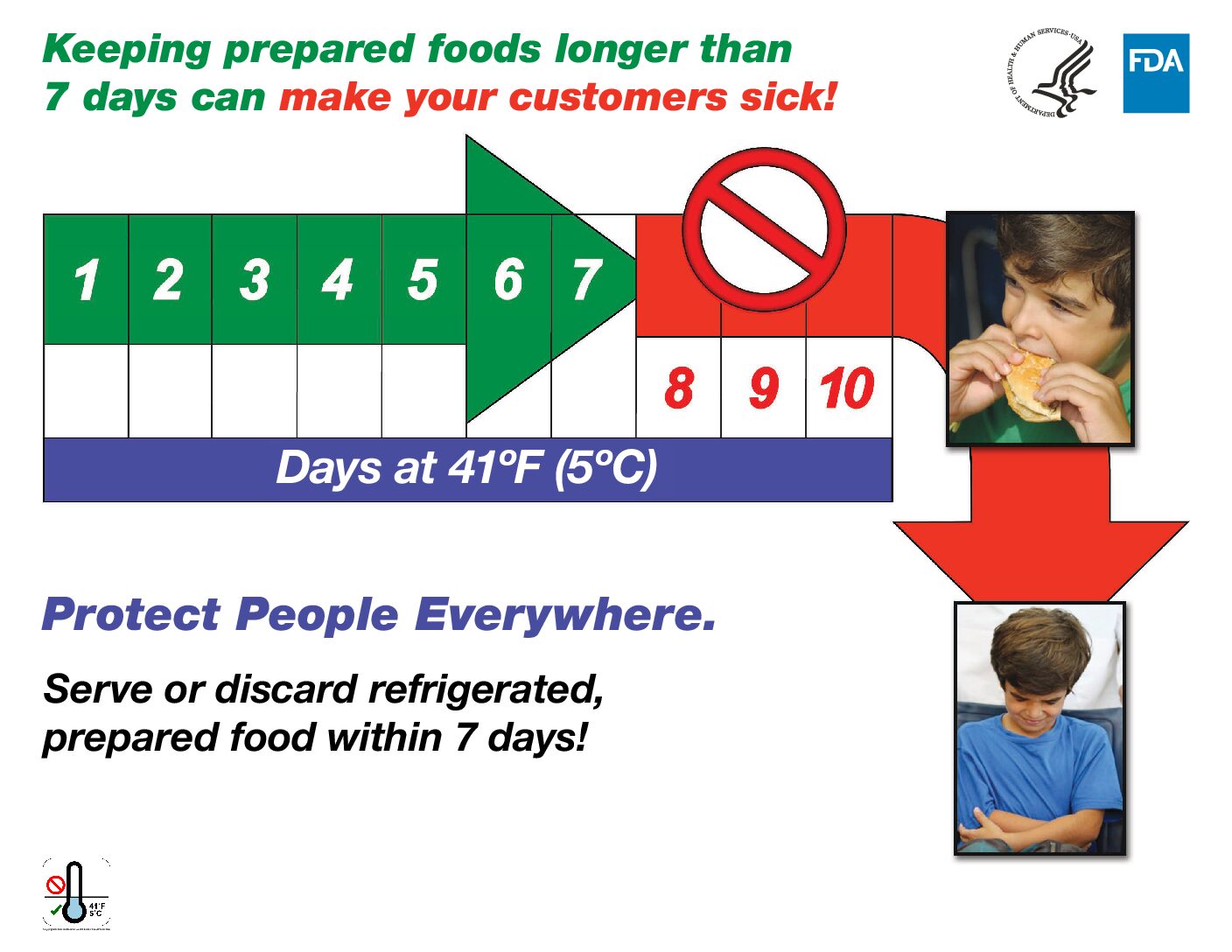Date Marking Retail Food Protection Poster featuring Young Boy_ English Version 1Date Marking Retail Food Protection Poster featuring Young Boy_ English Version 1Many jurisdictions require a storage limit for ready to eat foods. (Remember the definition of ‘ready to eat’? Even if you might reheat a food before service, if the food can be consumed without that step, it’s considered ‘ready to eat’). The FDA Food Code contains the following rule (even if your local ordinance does not use this rule, it makes good sense to use it). Note that ‘first in, first out’ rules are a variation of this rule. There are many good reasons to rotate stock and use it rapidly.
3-501.17 Ready-to-Eat, Time/Temperature Control for Safety Food, Date Marking.
- Except when PACKAGING FOOD using a REDUCED OXYGEN PACKAGING method as specified under § 3-502.12, and except as specified in ¶¶ (E) and (F) of this section, refrigerated, READY-TO -EAT, TIME/TEMPERATURE CONTROL FOR SAFETY FOOD prepared and held in a FOOD ESTABLISHMENT for more than 24 hours shall be clearly marked to indicate the date or day by which the FOOD shall be consumed on the PREMISES, sold, or discarded when held at a temperature of 5oC (41oF) or less for a maximum of 7 days. The day of preparation shall be counted as Day 1. (FDA 2013 Code)
Why? What’s the reason for this rule? This blog entry explores the scientific reason for the ‘7-day storage’ rule.
The reason behind this rule is that some bacteria can grow under refrigeration, below 41 degrees F. and lower. Salmonella, Listeria and Yersinia are three bacteria which might be found in refrigerated foods, either from inadequate cooking, poor personal hygiene, or any number of types of cross contamination (uncovered foods, employee handling with bare hands is two). Salmonella grows slowly at 40-41 degrees F, Yersinia can grow at 39.2 degrees F while Listeria can grow at temperatures as low as 33.8 degrees F. (This is one major reason why required cold food temperatures have changed, over the years, from 45F to 41F.)
Before you empty out your refrigerator, don’t panic! While these three microorganisms will survive at low temperatures and grow in many types of foods, growth will be slower in colder temperatures and faster in foods with higher protein and moisture content. Be warned: if you lose track of the storage times, that growth might make food unsafe. Hence, the storage time and labeling rules, so you can easily keep track and discard outdated foods.
Remember the rules about the growth of bacteria. One example: if I hire you for 30 days, starting your pay at one cent and doubling it every day, the growth will be explosive in 30 days. This is how bacteria grow, doubling their number each growth cycle.
There is a level of contamination, numbers of bacteria, often used to indicate when food borne illness is likely, when most people will become ill. (When contaminated foods are analyzed in a laboratory, this number is often used to indicate if a foodborne illness has likely occurred.) Scientific studies of the growth of Listeria show that seven days (preparation date plus six days) is the maximum storage time where TCS (‘temperature control for safety’) or potentially hazardous foods might still be expected to be safe. Fortunately, most chefs would never hold refrigerated ready to eat foods this long, just for taste and quality factors, (Spoilage bacteria produce changes in the taste of food starting at temperatures as low as 25F). So, if foods are properly labeled, kept covered, stored at temperatures below 41F and discarded if not used quickly, problems are not likely to occur.
Rules are always easier to understand and follow once you know the reasons behind them. This blog will post many more articles like this. If a rule has you confused, please let me know. I’ll research it and post an explanation here. Thanks for reading – good eats!

